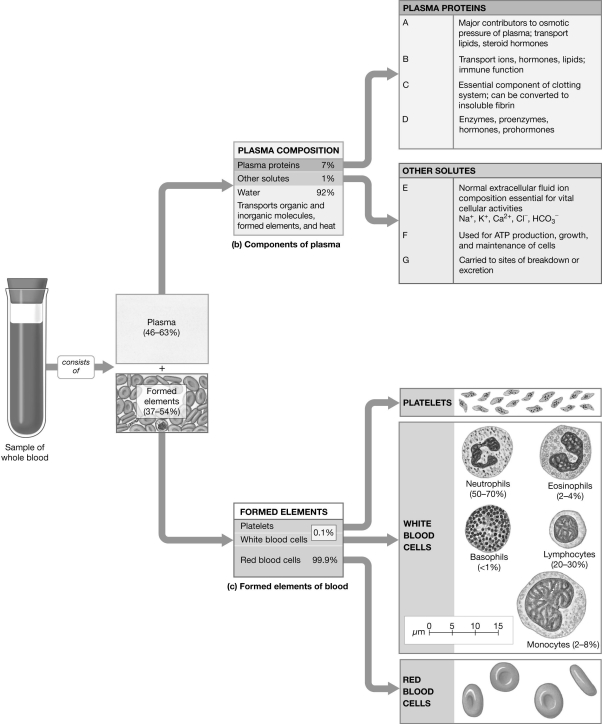Correct Answer

verified
Correct Answer
verified
Multiple Choice
Plasma is the ________ fraction of blood.
A) serum.
B) lymphatic fluid.
C) whole blood.
D) extracellular fluid.
E) packed blood.
G) A) and D)
Correct Answer

verified
D
Correct Answer
verified
Short Answer
When hemoglobin is broken down, a green pigment called _________________________ is produced.
Correct Answer

verified
biliverdin
Correct Answer
verified
Multiple Choice
Which of the following is an agranulocyte?
A) erythrocyte
B) WBC
C) monocyte
D) eosinophil
E) thrombocyte
G) None of the above
Correct Answer

verified
Correct Answer
verified
Short Answer
 -Label C: ________
-Label C: ________
Correct Answer

verified
Correct Answer
verified
Short Answer
Neutrophils, eosinophils, and basophils are all specifically classified as _________________________.
Correct Answer

verified
Correct Answer
verified
Multiple Choice
Fresh whole blood is collected by
A) arthroscopy.
B) arterioscopy.
C) venipuncture.
D) sonography.
E) venoscopy.
G) A) and B)
Correct Answer

verified
Correct Answer
verified
Multiple Choice
A normal WBC count is about
A) 1,000-2,000.
B) 500-5,000.
C) 5,000-10,000.
D) 50,000-500,000.
E) 5 million-6 million.
G) A) and C)
Correct Answer

verified
Correct Answer
verified
Short Answer
 -Label D: ________
-Label D: ________
Correct Answer

verified
Regulatory...View Answer
Show Answer
Correct Answer
verified
View Answer
Multiple Choice
The function of hemoglobin is to
A) carry oxygen.
B) protect the body against infectious agents.
C) aid in the process of blood clotting.
D) carry nutrients from the intestine to the body's cells.
E) all of the above
G) A) and C)
Correct Answer

verified
Correct Answer
verified
Multiple Choice
Red blood cell production is regulated by a hormone from the
A) thymus.
B) lungs.
C) kidney.
D) suprarenal gland.
E) brain.
G) A) and C)
Correct Answer

verified
Correct Answer
verified
Multiple Choice
Platelets are
A) giant, multinucleated cells.
B) cytoplasmic fragments.
C) immature leukocytes.
D) both A and B
E) all of the above
G) All of the above
Correct Answer

verified
Correct Answer
verified
Multiple Choice
The white blood cells that are important in leaving the blood vessels and phagocytizing large materials are
A) neutrophils.
B) eosinophils.
C) basophils.
D) lymphocytes.
E) monocytes.
G) A) and C)
Correct Answer

verified
Correct Answer
verified
Multiple Choice
The basic event that causes a blood clot to form is the change of
A) prothrombin to thrombin.
B) Factor X to Factor Xa.
C) fibrinogen to fibrin.
D) vitamin K to prothrombin.
E) PDGF to platelet.
G) A) and E)
Correct Answer

verified
Correct Answer
verified
Multiple Choice
Blood is composed of
A) plasma.
B) formed elements.
C) blood cells.
D) cell fragments.
E) all of the above
G) C) and D)
Correct Answer

verified
Correct Answer
verified
Multiple Choice
Which of the following represents the correct sequence of appearance for mature red blood cells?
A) stem cell, erythroblast stage, proerythroblast, reticulocyte, RBC
B) hemocytoblast, myeloblast, reticulocyte, megakaryocyte, RBC
C) myeloid stem cell, proerythroblast, erythroblast, reticulocyte, RBC
D) monoblast, promonocyte, myelocyte, band cell, RBC
E) lymphoblast, proerythroblast, reticulocyte, band cell, RBC
G) B) and C)
Correct Answer

verified
Correct Answer
verified
Multiple Choice
The main event of the coagulation phase is
A) vascular spasm.
B) the activation of fibrinogen.
C) clot retraction.
D) the formation of a platelet plug.
E) the contraction of platelets.
G) A) and B)
Correct Answer

verified
Correct Answer
verified
Essay
Match the formed element in the first column with its characteristic in the second. _____ 1. RBC A. anucleated and biconcave _____ 2. WBC B. anucleated and a cell fragment _____ 3. platelet C. nucleated and spheroid
Correct Answer

verified
Correct Answer
verified
Multiple Choice
What effect would a drug that interferes with protein synthesis have on the development of red blood cells?
A) Fewer cells than normal would be formed.
B) The cells formed would not be able to carry as much oxygen as normal.
C) The cells formed would carry larger amounts of carbon dioxide.
D) The cells would be round like spheres.
E) all of the above
G) None of the above
Correct Answer

verified
B
Correct Answer
verified
Multiple Choice
Platelets function in
A) transporting chemicals important for clotting.
B) forming temporary patches in injured areas.
C) contraction after clot formation.
D) initiating the clotting process.
E) all of the above
G) A) and B)
Correct Answer

verified
Correct Answer
verified
Showing 1 - 20 of 80
Related Exams